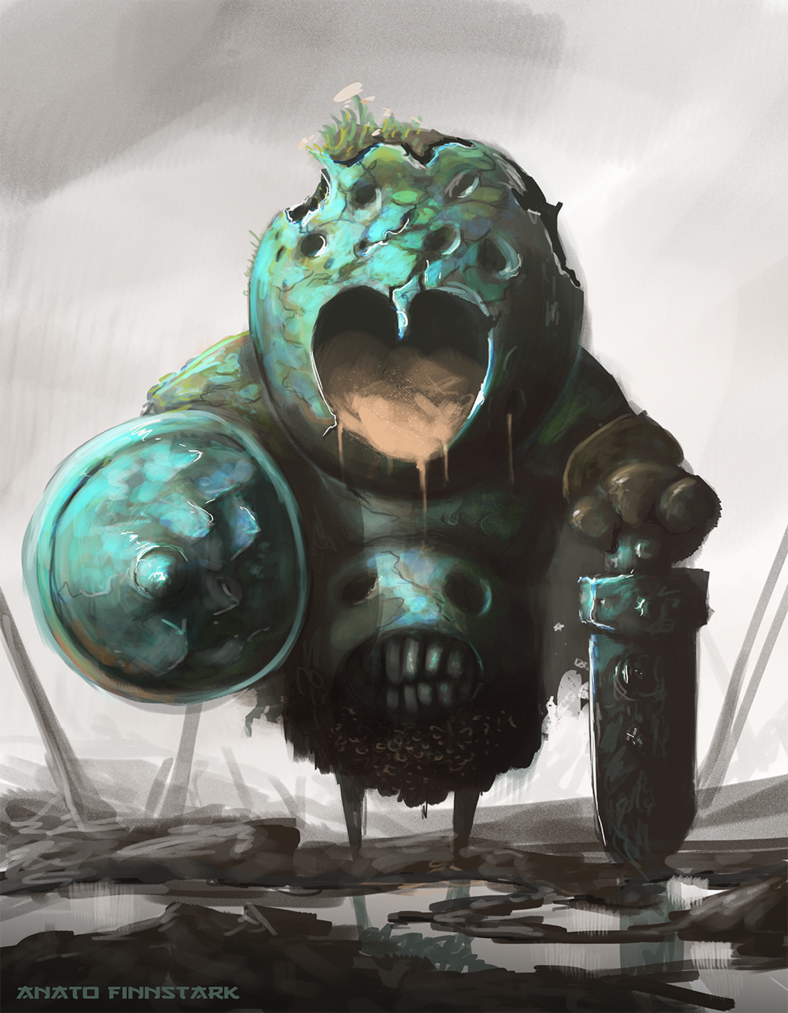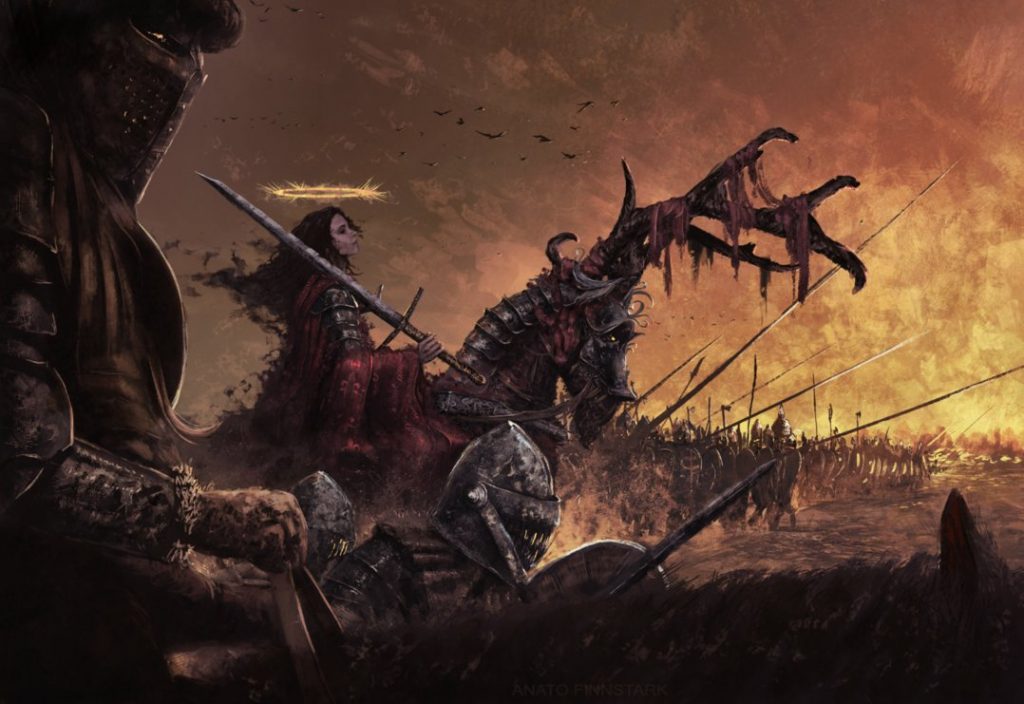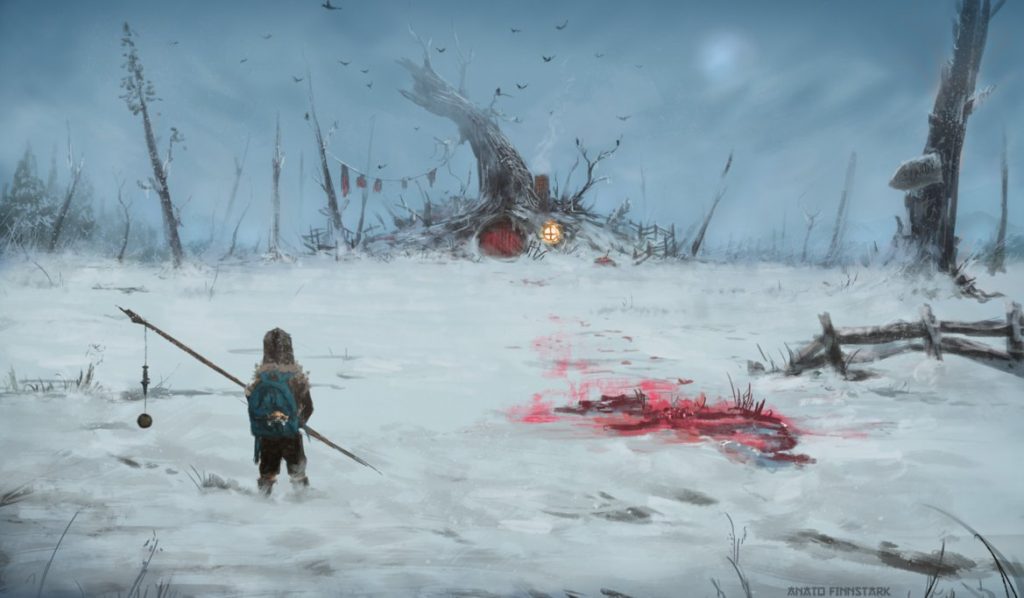Due to some incredibly rainy piss-poor days and being a novice with a camera, I’ve been forced to push back my reviews. Oops.
However, something keeps coming up in my chats and mentions, posts and public conversations: Realism. There are generally three sides to this argument, people who want to calculate the air-speed velocity that human tissue begins to release from bone, people who let their PCs flap their arms hard enough to fly, and the poor players and GMs caught in the middle.
How can you best navigate the argument? How do you decide what stance you take? How can you defend your ruling against Rules Lawyers or Implacable GMs? Let’s dissect this thing for the world to see.
Art by AnatoFinnstark
The Arguments
I want you, at the end of this article, to walk away understanding both sides of the conflict. I don’t want to pitch these ideas to you in a way that might sway you or misinform. So come at this with an open mind, as if you’re trying to give feedback on a photo, regardless of its content.
For Realism: The game should mirror the world in which we live as much as possible. It not only helps the players understand the consequences of given actions, but helps the GM to adjudicate the rules more succinctly and more fairly across the entire scope of the game. Mechanics can be re-formed and used to show the benefits and detriments of real-world pros and cons.
Most common defenses: “It makes sense.” “I’ve done it.” “You can read the science of it online.” “But that’s not how it’d work in real life.”
Against Realism: At the end of the day, it’s a game. Players should learn about the world but not be restricted by what happens in the real world. The GM should decide the rules on a case-by-case basis so long as everyone is having fun. No matter how impractical or insane – with a high enough roll, a player should be able to do whatever they want so long as it doesn’t break the game. Mechanics don’t really matter, they’re just a construct to help the story along.
Most common defenses: “It’s just a game.” “Rule of Cool.” “Get your science out of my [Insert Tabletop].” “The PCs are practically gods anyway, they’re above the rules.”
Neutral Third Party: It’s a game, but it needs to make sense. Players and the GM should decide what matters and what doesn’t together – but stick to it. The GM needs to follow the rules but not enforce them at the cost of the game’s fun. High rolls are great, but impossible is still impossible. Mechanics are a framework to build off of.
Most common defenses: “Does it make sense in the moment?” “That doesn’t make sense.” “Only if it adds to the game.”
These are certainly not the only arguments, defenses, etc to be had, but they are a generalization. About 60% of all players I speak to fall into the “neutral” category – they just want to go, have fun, roll some dice, and make some memories. They’re the closest thing this whole thing has to a “control.” No matter the outcome of an argument, the neutral party will generally side with whoever presents their argument with the least shit-talking and screaming – which is good!
Realism – How It’s Important
Adding realism to your game does help add anchor points for your party to latch on to. When you say “a fireplace full of hot coals” players can snap to the smell, the way the coals glow orange and ashy grey, the sound of wood snapping and popping as a fire dies; in the same vein – when a GM says “The train is moving 60 miles per hour” – it gives cues to the players: it’s dangerous to jump off the train, the wind is rushing by hard, the wheels are clattering like mad, if the train hits something it might derail at that speed.
Now let me say “The train is moving 60 miles per hour, and you see a man lounging on top of the train, still dressed in his business suit, eating a bowl of noodles.” Okay? We’ve painted a very odd picture in our heads. an older man with his tie flapping like crazy, hot stock from his soup spraying out into his face as he slides along the top of the train, trying desperately to get noodles into his mouth and not in his eyes; right?
But players sometimes don’t think about those kinds of details, they’re thinking about the plot, the characters, the setting, the time crunch, the threat, their skills and abilities, the dice, and a dozen other factors – so when Jarrk, the Half-troll infiltrator in a tailored business suit needs to make it to Compartment F from compartment D and says “Okay, I’ll climb up the ladder between cars and get up on the roof and sneak my way down there.” The GM can adjudicate pretty quickly: “Alright, you open the door and feel the air rushing by while the train rattles down the tracks. Looking up there, you can tell it’s going to be hard to make your way down the train without falling off – especially since it’s been misty all day outside. Do you still want to do it?”
Most people would agree, that’s pretty fair. It frames the argument of why such a feat would be difficult without seeming to be manufactured to be difficult (more on that later). Without adding that level of realism – just letting Jarrk trot down the train unimpeded, it’d stick in the craw of many people because it subverts implacable laws of nature for us.
Un-Realism – How it’s Important
Like any good antithesis, unrealistic players and DMs often have fantastical (often goofy) stuff happen in their game for the sake of levity or general impressiveness. These are the folks that generally have a great time, but often end up sapping the life from more serious players/DMs. After all, it IS impressive to surf on a shield and fire five arrows at once into five different guys over 300 feet away – but seeing it in Game of Thrones wouldn’t make a whole lot of sense, now would it?
 The importance here is that – these games are fantastical. Our lives are mundane enough – why not have a staff that is also a living sapient snake? Why couldn’t you cut through an armored car with your combat knife if it has Armor Piercing – opening it like a tuna can? So long as these antics don’t supplant the implacable laws of nature – generally speaking, people don’t make a fuss.
The importance here is that – these games are fantastical. Our lives are mundane enough – why not have a staff that is also a living sapient snake? Why couldn’t you cut through an armored car with your combat knife if it has Armor Piercing – opening it like a tuna can? So long as these antics don’t supplant the implacable laws of nature – generally speaking, people don’t make a fuss.
You want to wrap a rope around your arm and leap off an airplane to catch your falling companion? Let’s roll and see how it works – doesn’t really matter if it’d rip your arm off and kill you both, because it’s amazing. It’s a fun and interesting method to overcome an obstacle and should be rewarded. These are some of the stories that people tell for years and years – like the time you used your Mimicry feature to convince a bunch of cultists that you were their dark god (who you heard speaking once) – and ordering them all to commit ritualistic suicide – but to YOU instead of their actual dark god, thus ending the cult problem.
The vehement realism fanatics should look at these moments as points of zaniness that give their gritty realism contrast and weight – if nothing exceptional ever happened, then the mundane would seem exceptional, after all.
Implacable Laws
There are four things that humans know, even if they do not understand why exactly. Gravity (falling objects hurt), the passage of time (things get old and die), the fundamentals of life (food, sleep, air, water), and physics (*stares off into the middle distance as math equations fly overhead*).
Now this is kind of important – people who want “realism” in their games often harp on these laws. While I support representing them in your game, taking them too far can be detrimental, but think about it: “You can’t take your armor off that quickly.” “There’s no way its legs could support its body.” “If he were that strong he couldn’t even move anymore.” “Electricity travels quicker than that.” Etc. Etc.
So why are these “laws” so hard for Realism supporters to break in their game? Because even in fantasy, there are limitations. There may be spells that let a buffalo fall as slowly as a feather, creatures that live thousands upon thousands of years, cybernetic enhancements that let you breathe underwater or never sleep, even personal teleportation devices that let appear wherever you want. But each of them are within reason.
If everything fell as slowly as feathers, nothing ever aged, you didn’t really need sleep or food or water, or you could break through a concrete wall with an egg – then the entire game has to change in order to accommodate those things. Almost always, a game is not designed for that kind of skewed reality – the few that are do so by leaving such rules and roles ambiguous.
My favorite of these arguments that I use to point out how D&D 5e is designed to be fun and quick to play is this:
Modrik, a level 4 Half-Orc Barbarian, a tall lean man who likes to whistle, is on his way to see his mother in Waterdeep. He’s cut two days off of his journey by traveling by Hawk’s Nest and skirting along a rather deep ravine. He’s whistling a jaunty traveling tune to himself when an 8 foot tall 700 lb demon grabs him and throws him into the ravine – he falls 10,000 feet and lands face-first on the jagged toothy rocks. Modrik stands up, spits out some blood, and looks around… still alive.
Modrik’s HP = 45. Each 10 feet you fall deals 1d6 damage to you (maximum 20d6) – we roll 20d6 and get 74 damage. Modrik’s Half Orc racial ability lets him stand back up with 1hp when he’s not killed outright by a single attack.
The demon tears off a chunk of stone 10 foot wide and hurls it down 10,000 feet and it smashes onto Modrik’s head, dealing 43 points of damage. Modrik falls unconscious.
Modrik’s current HP = 1. If an attack deals enough damage to you that it brings you to a negative value equal to your hit point maximum (-45) it kills you outright. This attack brought him to -44, so he’s knocked out.
The demon then grabs his sword and hurls it down the ravine – blistering with magical fire. It stabs into Modrik’s chest, searing the wound into a bubbling mass around the blade – dealing 39 points of slashing and fire damage. He takes 1 death failure. The demon then tips over a 15 ft wagon that hurtles down to the ravine floor, smashing into Modrik, dealing 41 points of Bludgeoning damage. He suffers another death saving throw failure.
Modrik’s currently unconscious, but must fail 3 death saving throws to be killed. An attack from within 5 feet while you are unconscious counts as two death saving throw failures. An attack at range or an area of effect only counts as one, though. Again – an attack must deal damage to you equal to your maximum hit points in order to kill you outright, which this one does not.
The demon, satisfied, trudges off. Modrik succeeds on three death saving throws, leaving him alive and in stable condition at the bottom of the 10,000 foot ravine! His mother will see her son again! But wait… is that a tiny spotted-backed cave frog? The cave frog, chasing a beetle, leaps its little 1 inch body over and accidentally nibbles on Modrik’s finger. He takes 1 point of damage, and suffers 2 death saving throw failures. The frog nips him again, for 1 point of damage – and he dies.
Notice the HUGE disparity there in what could/would/and should potentially kill Modrik? A 10,000 foot fall where you land face-first on stone should be instant death – most people agree on that – but here we played by the D&D rules to the conclusion – which… was pretty damn sad, if you ask me.
Here, realism is cast aside in favor of the mechanics of the game, which make absolutely no sense. Thus, Realism defenders would argue, correctly I’d say, that such a fall would deal damage up to 150d6 (1d6 per 10 feet, up to the terminal velocity of a person – 1,500 feet). There’s almost no way that Modrik would survive such a fall, but if he did – a realism enthusiast would probably be so impressed that the demon would just walk away, assuming the job was complete and not wanting to waste time, leaving Modrik at the base of the pit conscious and able to fend off tiny near-harmless frogs.
Striking a Balance
Think about the implacable laws any time you’re considering an off-the-cuff laughable moment. Is what you’re trying to do so absurd you’d scoff at it in a movie? (I’m looking at you, EVERY Fast and the Furious movie after the first one). Likewise, does your instinct to thump your book against the table and screech “THAT’S NOT REALISTIC” add anything to the game? Will making your characters DRAG a statue back to their car be any more important or fun than letting them CARRY the thing? Just ask yourself “If I heard an argument about this at work – not pertaining to a game – would it bore the hell out of me?” – if yes, don’t do it.
 “Margot and I bought a grill last week, we’ll be picking it up today.” “Oh, do you think you can fit it in the back of your SUV?” “I certainly think so – it’s only 46 inches long.” “AH, but you see, the top is square, where your SUV is more rounded along the back-” (sounds of internal mental suicide).
“Margot and I bought a grill last week, we’ll be picking it up today.” “Oh, do you think you can fit it in the back of your SUV?” “I certainly think so – it’s only 46 inches long.” “AH, but you see, the top is square, where your SUV is more rounded along the back-” (sounds of internal mental suicide).
The big thing you need to address is: what kind of group am I in?
If you’re in a group with people who want to flap their arms when they fall and fly – like a Looney Toons cartoon, then you may not want to push too many Realism judgements onto them – they might feel alienated and think your game is un-fun.
Likewise, if you’re in a group of people who want to keep track of food and water, who plan out their travel to make sure they have enough time in the day to make rests – then having a wizard fart them to death might not be in keeping with their tone.
Final Thoughts
It’s all, in the end, about fun. Your fun and their fun. If you plant your feet and demand they make a Realistic roll for a Realistic situation – consider sprinkling in something fantastical or weird to make up for it. If you make them go up against a gang of clowns that are completely invincible unless you make them laugh – consider tempering that with some Realistic exhaustion mechanics for them not sleeping from the nightmares.
Ground them in realism, but let them play in the fantastical. Consider why Harry Potter is so loved – it’s a direct mirror of our world but covered fantastic trappings of magic and mystery. Let your game shift between the two as well and you’ll all be happier for it.
Art By Anato Finnstark




